Zaporizhzhia
Zaporizhzhia (Ukrainian: Запоріжжя, lit. 'Beyond the Rapids') is a city in southeast Ukraine, situated on the banks of the Dnieper river. It is the administrative centre of the Zaporizhzhia Oblast (region).[3] Zaporizhzhia has a population of 710,052 as of 1 January 2022.
Zaporizhzhia
Запоріжжя | |
|---|---|
City | |
| Ukrainian transcription(s) | |
| • National | Zaporizhzhia |
| • ALA-LC | Zaporiz͡hz͡hi͡a |
| • BGN/PCGN | Zaporizhzhya |
| • Scholarly | Zaporižžja |
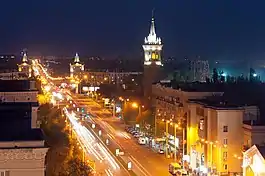 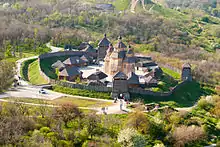 .JPG.webp) .jpg.webp)   .jpg.webp) 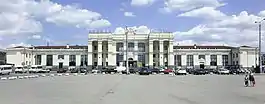 From top to bottom and left to right:
| |
.svg.png.webp) Flag  Coat of arms | |
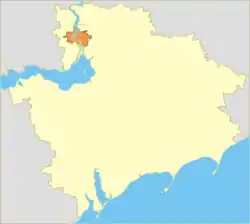 Zaporizhzhia Oblast (yellow) with the City of Zaporizhzhia (orange) | |
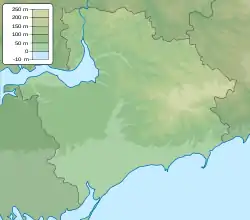 Zaporizhzhia  Zaporizhzhia | |
| Coordinates: 47°51′00″N 35°07′03″E | |
| Country | |
| Oblast | |
| Founded | 952 |
| City rights | 1806 |
| Raions | 7
|
| Government | |
| • Mayor | Anatoliy Kurtyev (acting Mayor since 30 September 2021)[1] |
| Area | |
| • Total | 334 km2 (129 sq mi) |
| Population (2021) | |
| • Total | 722,713 |
| • Density | 1,365.2/km2 (3,536/sq mi) |
| • 2001[2] | 817,900 |
| Time zone | UTC+2 (EET) |
| • Summer (DST) | UTC+3 (EEST) |
| Postal code | 69xxx |
| Area code | +380 61(2) |
| Climate | Dfa |
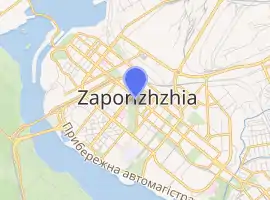 | |
Zaporizhzhia is known for the historic island of Khortytsia; multiple power stations including Zaporizhzhia Nuclear Power Plant (the largest nuclear power station in Europe), Zaporizhzhia thermal power station and Dnieper Hydroelectric Station and for being an important industrial centre. Steel, aluminium, aircraft engines, automobiles, transformers for substations, and other heavy industrial goods are produced in the region.
Names and etymology
Renderings of the name include: Zaporizhzhia,[4] Zaporizhia, or Zaporizhzhya, pronounced UK: /ˌzæpɒˈrɪʒjə/, US: /ˌzɑːpəˈriːʒ(j)ə/, from Ukrainian: Запорі́жжя, IPA: [zɐpoˈr⁽ʲ⁾iʒːɐ] (![]() listen). Also Zaporozhye, US: /ˌzɑːpəˈroʊʒə/, from Russian: Запоро́жье, IPA: [zəpɐˈroʐjɪ]).
listen). Also Zaporozhye, US: /ˌzɑːpəˈroʊʒə/, from Russian: Запоро́жье, IPA: [zəpɐˈroʐjɪ]).
The name Zaporizhzhia literally refers to the position of the city located "beyond the rapids" – down-river or south of the Dnieper River rapids, formerly a major impediment to navigation and the site of important portages (in 1932, the rapids on the Dnieper river were flooded to become part of the reservoir of the Dnieper Hydroelectric Station).[5]
Before it was changed in 1921, the city's name was Aleksandrovsk (Russian: Алекса́ндровск [ɐlʲɪˈksandrəfsk]) or Oleksandrivsk (Ukrainian: Олекса́ндрівськ [olekˈsɑnd⁽ʲ⁾r⁽ʲ⁾iu̯sʲk]) after the name of a fortress (Russian: Александровская крепость, romanized: Aleksandrovskaya krepost; Ukrainian: Олександрівська фортеця, romanized: Oleksandrivska fortetsia) that formed a part of the Dnieper Defence Line of the Russian Empire.
History
Pre-foundation history

Archaeological finds show that about two or three thousand years ago Scythians lived around the modern city. Later, Khazars, Pechenegs, Kuman, Tatars and Slavs dwelt there. The trade route from the Varangians to the Greeks passed through the island of Khortytsia. These territories were called the "Wild Fields", because they were not under the control of any state (it was the land between the highly eroded borders of the Polish–Lithuanian Commonwealth, the Grand Duchy of Moscow, and the Ottoman Empire).
In 1552 Dmytro Vyshnevetsky erected wood-earth fortifications on the small island Little Khortytsia which is near the western shore of Khortytsia island. Archeologists consider these fortifications to be a prototype for the Zaporizhzhian Sich — the stronghold of the paramilitary peasant regiments of Cossacks.
Foundation of Zaporizhzhia
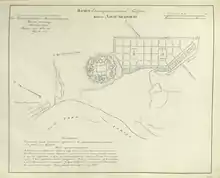
In 1770 the fortress of Aleksandrovskaya (Александровская) was erected and is considered to be the year of the foundation of Zaporizhzhia. As a part of the Dnieper Defence Line the fortress protected the southern territories of Russian Empire from Crimean Tatar invasions.[6] It is uncertain in whose honour the fortress was named. Some believe that it was Alexander Mikhailovich Golitsyn, the general who served Catherine the Great.[5] Other possibilities are Prince Alexander Vyazemsky[6][7] or Alexander Rumyantsev.[8]
In 1775, Russia and the Ottoman Empire signed the Küçük Kaynarca peace treaty, according to which the southern lands of the Russian Plain and Crimean peninsula became Russian-governed territories. As a result, the Aleksandrovskaya Fortress lost its military significance and converted into a small provincial rural town, known from 1806 under the name Alexandrovsk (Александровск).[5]
Mennonite settlers
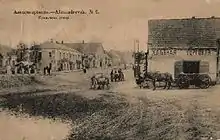
In 1789, Mennonites from the Baltic city of Danzig (Gdańsk) accepted the invitation from Catherine the Great to settle several colonies in the area of the modern city. The island of Khortytsia was gifted to them for "perpetual possession" by the Russian government. In 1914, the Mennonites sold the island back to the city. The Mennonites built mills and agricultural factories in Alexandrovsk.[9]
During the Russian Revolution and especially by World War II most of the Mennonites had fled to North and South America as well as being forcefully relocated to eastern Russia. At present, few Mennonites live in Zaporizhzhia, although in the area many industrial buildings and houses built by Mennonites are preserved.[10]
The ferry
In 1829, it was proposed to build a cable ferry across the Dnieper. The ferry could carry a dozen carts. The project was approved by Tsar and later was used in other parts of the Russian Empire. In 1904 the ferry was replaced by the Kichkas Bridge (see next section), which was built in the narrowest part of the river called "Wolf Throat", near to the northern part of the Khortytsia Island.[11]
Establishment of railway and Kichkas Bridge
The first railway bridge over the Dnieper was the Kichkas (Кичкасский) Bridge, which was designed by Y.D. Proskuryakov and E. O. Paton. The construction works were supervised by F. W. Lat. The total bridge length was 336 m (1,102 ft). It crossed the river with a single span of 190 m (620 ft). The upper tier carried a double-track railway line, whilst the lower tier was used for other types of vehicles; both sides of the bridge were assigned as footpaths. It was built at the narrowest part of the Dnieper river known as Wolf Throat. Construction started in 1900, and it opened for pedestrian traffic in 1902. The official opening of the bridge was 17 April 1904, though railway traffic on the bridge only commenced on 22 January 1908.[11] The opening of the Kichkas Bridge led to the industrial growth of Alexandrovsk.[11]
In 1916, during World War I, the aviation engines plant of DEKA Stock Association (today better known as the Motor Sich) was transferred from Saint Petersburg.[12]
Civil war (1917–1921)
The Kichkas Bridge was of strategic importance during the Russian Civil War, and carried troops, ammunition, the wounded and medical supplies. Because of this bridge, Alexandrovsk and its environs was the scene of fierce fighting from 1918 to 1921 between the Red Army and the White armies of Denikin and Wrangel, Petliura's Ukrainian People's Army of the Ukrainian People's Republic and German-Austrian troops, and after their defeat, the struggle with insurgents led by Hryhoriv and Makhno. The bridge was damaged a number of times. The most serious damage was inflicted by Makhno's troops when they retreated from Alexandrovsk in 1920 and blew a 40-metre-wide (130 ft) gap in the middle of the bridge.[11]
People's Commissar of Railways Dzerzhinsky of the Bolshevik government ordered the repair of the bridge. The metallurgical plant of the Bryansk joint-stock company (present day Dniprovsky Metallurgical Plant) in Katerynoslav (today Dnipro) built a replacement section. The Kichkas Bridge reopened on 14 September 1921.[11] On 19 October 1921, the Soviet Council of Labor and Defense (chaired by Lenin) awarded the Yekaterininsky railroad the Order of the Red Banner of the Ukrainian Soviet Socialist Republic for the early restoration of the Kichkas Bridge.[11]
Industrialization in the 1920 – 1930s
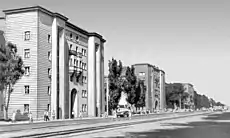
At the beginning of 20th century, Zaporizhzhia was a small unremarkable rural town of the Russian Empire, which acquired industrial importance during the industrialization carried out by the Soviet government in the 1920s and 1930s. In 1929–1932, a master plan for city construction was developed. At 10 km (6.2 miles) from the old town Alexandrovsk at the narrowest part of the Dnieper river was planned to build the hydroelectric power station, the most powerful in Europe at that time. Close to the station should be constructed the new modern city and a giant steel and aluminum plants. Later the station was named "DnieproHES", the steel plant – "Zaporizhstal'" (Zaporizhzhia Steel Plant), and the new part of the city – "Sotsgorod".[13] (Socialist city)[14][15] Production of the aluminum plant ("DAZ" – Dnieper Aluminium Plant) according to the plan should exceed the overall production of the aluminum all over Europe at that time.[16]
State Institute for Design of Metallurgical Plants (GIPROMEZ) developed a project of creation of the Dnieper Industrial Complex. GIPROMEZ consulted with various companies, including the Freyn Engineering Company of Chicago (USA), which participated in the design and construction of the blast furnaces.
In the 1930s the American United Engineering and Foundry Company built a strip mill, which produced hot and cold rolling steel strip. This was a copy of the Ford River Rouge steel mill. Annual capacity of the mill reached 540,000 tonnes (600,000 short tons). Strip width was 170 cm (66 inches).[17] There was a second section that used a Soviet copy of the Demag AG strip mill that produced 110 cm (45 inches) wide strip steel.[17]
The hydro-electric dam, DniproHES
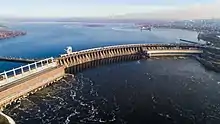
The turning point in the history of the city was the construction of the hydro-electric dam (DniproHES), which began in 1927 and completed in 1932. The principal designer of the project was I. G. Alexandrov, the construction manager – A. V. Vinter, the chief architect – V. A. Vesnin and the chief American advisor – the colonel Hugh Cooper. The installed generating capacity was 560 megawatts, the length of a convex dam was 760 m (2,490 feet), the width was 56 m (184 feet), the height was 60 m (200 feet).
Eight turbines and five electrical generators were designed and manufactured in the United States. The other three generators were made at the Leningrad factory Electrosila. After commissioning the Dnieper rapids were flooded, and the river became navigable from Kyiv to Kherson. In 1980 a new generator building was built, and the station power was increased to 1,388 megawatts
The city of Socialism (Sotsgorod)
Between the hydroelectric dam and industrial area in 10 km (6.2 miles) from the centre of the old Alexandrovsk was established residential district No. 6, which was named "Sotsgorod". In 20th doctrinaire idealistic enthusiasm of the architects was reflected in the intense debate about the habitation of the socialist community. The architects believed that by using new architectural forms they could create a new society. District No. 6 was one of the few implementations of urban development concepts. The construction of the district began in 1929 and finished in 1932.
The main idea guiding the architects was the creation of a garden city, a city of the future. Multi-storey houses (not more than 4 floors) with large, roomy apartments were built in Sotsgorod with spacious yards planted with grass and trees around the buildings. Nikolai Kolli,[18] V. A. Vesnin, G. M. Orlov, V. G. Lavrov and others designed the DniproHES and SotsGorod. Le Corbusier visited the town few times in the 1930s. The architects used the ideas of the constructivist architecture.
The ring house the building No. 31 at Independent Ukraine Street (formerly – 40 years of Soviet Ukraine Street) was designed by V. G. Lavrov. Families of the Soviet and American engineers, advisors, and industry bosses lived in Sotsgorod at that time. However, the most of the workers during the construction of the hydro-power station and plants lived in dugouts at No. 15 and Aluminum districts. The south border of the Sotsgorog is limited by Verkhnya Ulitsa (Upper Street) and north border – by the hydroelectric power station. At the intersection between Sobornyi Avenue and Verkhnya Street, architect I.L. Kosliner set a tower with seven stories. This tower supposedly indicates the entrance gate of Sotsgorod from the south (from Alexandrovsk). Closer to the dam, the second tower was raised (architects I.L. Kosliner and L.Ya. Gershovich). Both towers point out a straight line of the central street of the district.
The names of the streets have changed several times. The original name of Metallurgist Avenue was Enthusiasts Alley. This road leads to the factories. At that time, they believed that people going to the plant had only positive feelings like joy, pride, and enthusiasm. At the end of the road stands a 1963 sculpture of the metallurgist by sculptor Ivan Nosenko. During the German occupation, it was named Shevchenko Avenue. Later it was renamed Stalin Avenue; and after his death, it got the present name of Metallurgist Avenue. Sobornyi Avenue originally had the name Libkhnet Avenue. "Forty Years of Soviet Ukraine" Street was once called Sovnarkomovska Street and during the German occupation Hitler Alley.
Big Zaporizhzhia
District No. 6 is a small part of the global project called Big Zaporizhzhia. This project was designed for the city, to enable a half-million people to live in seven different areas: Voznesenka, Baburka, Kichkas, Alexandrovsk, Pavlo-Kichkas, Island Khortitsa, and (omitted). Each district must be independent of the others and yet part of а united city. The city line should be stretched along the banks of the Dnieper River for 22 km (14 miles).[19]
Dnieper railway bridges
The location of the Kichkas Bridge was in the flood zone upstream of the hydroelectric dam. Initially, it was planned to disassemble it and rebuild it in another location. But expert advice was that this was not cost-effective as it was cheaper to build a new bridge.[11]
The building of the hydroelectric dam meant that a new bridge was required to take the railway over the Dnieper. Instead of having a single bridge, as before, it was decided to take the railway over the island Khortytsia. The wide part of the river between Khortytsia and the city is known as the New Dnieper, and the narrower part between Khortytsia and the suburbs on the right bank of the river is known as the Old Dnieper.[11] The New Dnieper was crossed by a three-arch two-tier bridge. Each of the arches spans 140 m (460 ft). When the approach spans are included the total length is 715 m (2,346 ft) weighing 8,480 tonnes (9,350 short tons).[11]
The Old Dnieper was crossed by a single-span arch bridge with a total length of 370 m (1,210 ft); the arch spans of 224 m (735 ft) and was then the largest single-span bridge in Europe. This bridge weighed 5,220 tonnes (5,750 short tons).[11] Both bridges were designed by Professor Streletsky. They were made of riveted steel, and had two tiers: the upper tier for rail traffic and the lower tier for road traffic and pedestrians. They were assembled by a combination of Czechoslovakian and Soviet workers under the direction of a Soviet engineer named Konstantinov. The arches are steel made by the Vitkovetskom steel plant in Czechoslovakia, other steelwork was made at the Dnipropetrovsk Metallurgical Plant. The new bridges opened on 6 November 1931. The Kichkas Bridge was demolished afterwards.[11]
World War II (1941–1945)
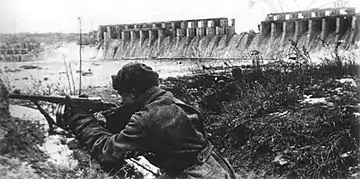
German occupation
The War between the USSR and Nazi Germany began on 22 June 1941.
After the outbreak of the war, the Soviet government started the evacuation of the industrial equipment from the city to Siberia.[20] The Soviet security forces NKVD shot political prisoners in the city.[21] On 18 August 1941, elements of the German 1st Panzergruppe reached the outskirts of Zaporizhzhia on the right bank and seized the island Khortytsia.[20][22]
The Red Army blew a 120m x 10m hole in the Dnieper hydroelectric dam (DniproHES) at 16:00 on 18 August 1941, producing a flood wave that swept from Zaporizhzhia to Nikopol, killing local residents as well as soldiers from both sides.[20] "Since no official death toll was released at the time, the estimated number of victims varies widely. Most historians put it at between 20,000 and 100,000, based on the number of people then living in the flooded areas".[23] After two days, the city defenders received reinforcements, and held the left bank of the river for 45 days.[20] During this time people dismantled heavy machinery, packed and loaded them on the railway platform, marked and accounted for with wiring diagrams.[20] Zaporizhstal alone exported 9,600 railway cars with the equipment.[20] Zaporizhzhia was taken on 3 October 1941.[11][24]
The German occupation of Zaporizhzhia lasted 2 years and 10 days.[20] During this time the Germans shot over 35,000 people, and sent 58,000 people to Germany as forced labour.[20] The Germans used forced labor (mostly POWs) to try to restore the Dnieper hydroelectric dam and the steelworks.[20] Local citizens established an underground resistance organization in spring 1942.[20]
The Krivoy Rog – Stalingrad and Moscow – Crimea railway lines through Zaporizhzhia were important supply lines for the Germans in 1942–43, but the big three-arch Dnieper railway bridge at Zaporizhzhia was blown up by the retreating Red Army on 18 August 1941, with further demolition work done during September 1941.[11] and the Germans did not bring it back into operation until summer 1943.[25][nb 2]
When the Germans reformed Army Group South in February 1943, it had its headquarters in Zaporizhzhia. The loss of Kharkiv and other cities caused Adolf Hitler to fly to this headquarters on 17 February 1943, where he stayed until 19 February and met the army group commander Field Marshal Erich von Manstein, and was persuaded to allow Army Group South to fight a mobile defence that quickly led to much of the lost ground being recaptured by the Germans in the Third Battle of Kharkov.[26][27] Hitler visited the headquarters in Zaporizhzhia again on 10 March 1943, where he was briefed by von Manstein and his air force counterpart Field Marshal Wolfram Freiherr von Richthofen.[28][29] Hitler visited the headquarters at Zaporizhzhia for the last time on 8 September 1943.[30] In mid-September 1943 the Army Group moved its headquarters from Zaporizhzhia to Kirovograd (now called Kropyvnytskyi).[31]
Both the big railway bridge over the New Dnieper and the smaller one over the Old Dnieper were damaged in an air raid by a group of eight Ilyushin Il-2s led by Lieutenant A Usmanov on 21 September 1943.[11]
Liberation
In mid-August 1943, the Germans started building the Panther-Wotan defence line along the Dnieper from Kyiv to Crimea, and retreated back to it in September 1943. The Germans held the city as a bridgehead over the Dnieper with elements of 40th Panzer and 17th Corps.[32] The Soviet Southwestern Front, commanded by Army General Rodion Malinovsky, attacked the city on 10 October 1943.[32] When the defenders succeeding in holding up the attacks, the Red Army reinforced its troops and launched a surprise night attack at 22:00 on 13 October,[20][33] "laying down a barrage of shellfire bigger than anything... seen to date (it was here that entire 'divisions' of artillery appeared for the first time) and throwing in no fewer than ten divisions strongly supported by armour".[31]
The Red Army broke into the bridgehead, forcing the Germans to abandon it on 14 October.[20] The retreating Germans destroyed the Zaporizhstal steel plant almost completely;[20] they demolished the big railway bridge again,[31] and demolished the turbine building and damaged 32 of the 49 bays of the Dnieper hydro-electric dam.[20] The city has a street between Voznesenskyi and Oleksandrivskyi Districts and a memorial in Oleksandrivskyi District dedicated to Red Army Lieutenant Mykola Yatsenko who commanded the first tank to enter Zaporizhzhia; he and his crew were killed in the battle for the city.[20][nb 3]
The Red Army did not recapture the parts of the city on the right bank until 1944.[20]
The rebuilding of the Dnieper hydro-electric dam commenced on 7 July 1944. The first electricity was produced from the restored dam on 3 March 1947.[20]
Contemporary (1991–present time)
.jpg.webp)
New bridges across Dnieper
The automobile transport connection between the right shore city districts and city centre via the Preobrazhensky bridge was already congested in the late nineties. In 2004, construction began on new bridges across the Dnieper called the New Zaporizhzhia Dniper Bridge. These bridges are parallel to the existing Preobrazhensky bridge at a short distance downstream. Construction of the bridges halted soon after it began, and remain untouched due to lack of funding. The project design is dated and needs revising, and the cost of the bridge is estimated to reach ₴8 billion (as opposed to the original ₴2 billion).[35] In mid-November 2020, a Turkish contractor announced that it was starting the final stage of commissioning the first phase of construction. The work was planned to be completed before December.[36]
Euromaidan events, 2013–2014
During the 2014 Euromaidan regional state administration occupations protests against President Viktor Yanukovych were also held in Zaporizhzhia.[37] On 23 February 2014 Zaporizhzhia's regional state administration building was occupied by 4,500 protesters,[38] Mid-April 2014 there were clashes between Ukrainian and pro-Russian activists.[39] The Ukrainian activists outnumbered the pro-Russian protesters.[40][41]
Renaming city streets, plants, culture centres (2016)
On 19 May 2016, the Verkhovna Rada approved the so-called "Decommunization Law."[42] Due to these laws the city council had to rename more than 50 main streets and the administrative parts of the city[nb 4], the monuments of the Soviet Union leaders (Lenin, Felix Dzerzhinsky) were destroyed.[43][44] The names honoring Soviet leaders in the titles of industrial plants, factories, culture centres and the DniproHES were removed.[45]
Russian invasion (2022)
During the 2022 Russian invasion of Ukraine, Russian forces have been engaged in ongoing attacks on the city. On 27 February, some fighting was reported in the southern outskirts of Zaporizhzhia.[46] Russian forces began shelling Zaporizhzhia later that evening.[47] On March 3, Russian forces approaching the Zaporizhzhia Nuclear Power Plant were fired upon disabling a tank, and responded causing a fire and concern about a potential nuclear meltdown. Firefighters were able to subdue the fire.[48][49] Russian military forces fired missiles on Zaporizhzhia on the evening of May 12 and May 13.[50] On 30 September, hours before Russia formally annexed Southern and Eastern Ukraine, the Russian Armed Forces launched S-300 missiles at a civilian convoy, killing 30 people and injuring 88 others.[51][52][53][54] On 9 October, Russian forces launched rockets at residential buildings, killing at least twenty people.[55][56][57]
Geography
The city is located in south-eastern Ukraine. The Dnieper river splits the city in two; between them is Khortytsia island. The city covers 334 km2 (129 sq mi) at an elevation of 50 m (160 ft) above sea level.[58]
There are two streams around Khortytsia island; New and Old Dnieper. The New Dnieper is about 800 m (2,600 feet) wide while the Old Dnieper is about 200 m (660 feet) wide. The island has 12 km × 2 km (7.5 mi × 1.2 mi) sizes. There are also several small rivers in the city, which enter the Dnieper: Sukha and Mokra Moskovka, Kushuhum, and Verkhnia Khortytsia.
The flora of Khortytsia island is unique and diverse due to the dry steppe air and a large freshwater basin, which cleans the air polluted by industry. Khortytsia Island is a national park. The island surface is cut by large ravines ("balka"), hiking routes and historical monuments. The island is a very popular recreational area for both kids and adults. There are a large number of sanatoriums, resorts and health centres. There are also sandy beaches with swimming access. [59]
Climate
| Climate data for Zaporizhzhia (1991–2020, extremes 1959–present) | |||||||||||||
|---|---|---|---|---|---|---|---|---|---|---|---|---|---|
| Month | Jan | Feb | Mar | Apr | May | Jun | Jul | Aug | Sep | Oct | Nov | Dec | Year |
| Record high °C (°F) | 12.2 (54.0) |
17.1 (62.8) |
24.0 (75.2) |
31.4 (88.5) |
35.9 (96.6) |
36.5 (97.7) |
39.5 (103.1) |
40.2 (104.4) |
35.9 (96.6) |
35.0 (95.0) |
20.9 (69.6) |
16.0 (60.8) |
40.2 (104.4) |
| Average high °C (°F) | −0.3 (31.5) |
1.2 (34.2) |
7.5 (45.5) |
16.1 (61.0) |
22.6 (72.7) |
26.6 (79.9) |
29.3 (84.7) |
29.0 (84.2) |
22.7 (72.9) |
14.7 (58.5) |
6.5 (43.7) |
1.3 (34.3) |
14.8 (58.6) |
| Daily mean °C (°F) | −3.1 (26.4) |
−2.2 (28.0) |
3.0 (37.4) |
10.5 (50.9) |
16.7 (62.1) |
20.9 (69.6) |
23.2 (73.8) |
22.6 (72.7) |
16.7 (62.1) |
9.7 (49.5) |
3.1 (37.6) |
−1.3 (29.7) |
10.0 (50.0) |
| Average low °C (°F) | −5.8 (21.6) |
−5.3 (22.5) |
−0.9 (30.4) |
5.0 (41.0) |
10.9 (51.6) |
15.2 (59.4) |
17.1 (62.8) |
16.4 (61.5) |
11.3 (52.3) |
5.5 (41.9) |
0.2 (32.4) |
−3.8 (25.2) |
5.5 (41.9) |
| Record low °C (°F) | −29.3 (−20.7) |
−26.1 (−15.0) |
−25 (−13) |
−8.2 (17.2) |
−2 (28) |
3.9 (39.0) |
8.2 (46.8) |
3.9 (39.0) |
−3 (27) |
−8.9 (16.0) |
−18.6 (−1.5) |
−26.2 (−15.2) |
−29.3 (−20.7) |
| Average precipitation mm (inches) | 39 (1.5) |
32 (1.3) |
37 (1.5) |
41 (1.6) |
51 (2.0) |
61 (2.4) |
45 (1.8) |
44 (1.7) |
38 (1.5) |
34 (1.3) |
40 (1.6) |
53 (2.1) |
515 (20.3) |
| Average extreme snow depth cm (inches) | 7 (2.8) |
8 (3.1) |
4 (1.6) |
0 (0) |
0 (0) |
0 (0) |
0 (0) |
0 (0) |
0 (0) |
0 (0) |
1 (0.4) |
3 (1.2) |
8 (3.1) |
| Average rainy days | 10 | 8 | 11 | 12 | 13 | 13 | 10 | 8 | 10 | 11 | 13 | 11 | 130 |
| Average snowy days | 14 | 14 | 9 | 1 | 0 | 0 | 0 | 0 | 0 | 1 | 6 | 13 | 58 |
| Average relative humidity (%) | 85.2 | 82.4 | 77.6 | 67.2 | 63.1 | 66.0 | 63.6 | 62.1 | 68.5 | 75.5 | 84.3 | 86.1 | 73.5 |
| Source 1: Pogoda.ru.net[60] | |||||||||||||
| Source 2: World Meteorological Organization (humidity 1981–2010)[61] | |||||||||||||
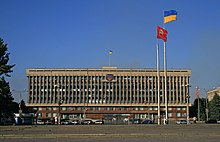
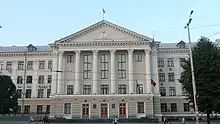
Governance
Zaporizhzhia is a regional seat of Zaporizhzhia Oblast and a city of regional significance meaning that it has a form of self-rule within the oblast (region).
Administrative subdivision
The city is divided into 7 administrative raions.
|
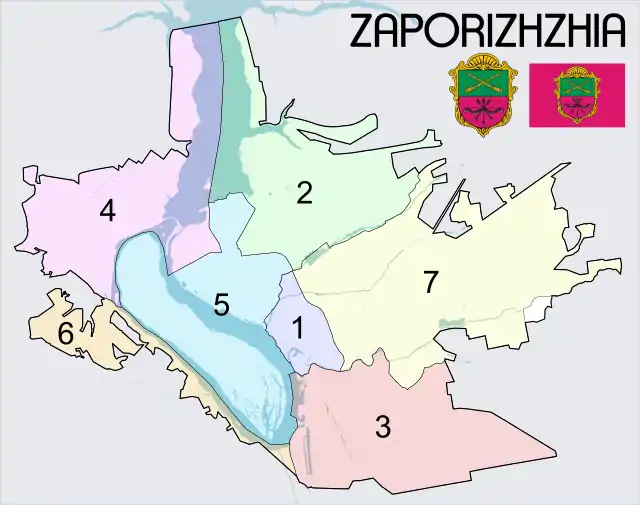 Zaporizhzhia administrative subdivision (Raions) |
Demographics
City population
The city population has been declining since the first years of the state independence. In 2014–2015 the rate of the population decrease was −0.56%/year.[63]
In January 2017, the city population equaled 750,685 inhabitants[64] The total reduction of the population of the city during the state independence is around 146 thousand people (the years 2017–2018 are not included in this estimation)
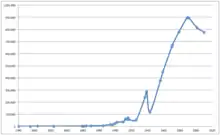
|
|
|
Ethnic structure
According to the 2001 census, Zaporizhzhia had the following ethnic structure:[86]
| Total (thousands) | Ukrainians | Russians | Belorussians | Bulgarians | Jews | Georgians | Armenians | Tatar | Azeris | Roma (Gypsies) | Poles | Germans | Moldovans | Greeks |
|---|---|---|---|---|---|---|---|---|---|---|---|---|---|---|
| 815.3 | 573 | 207 | 5.5 | 3.6 | 3.4 | 3.11 | 3.08 | 2.2 | 1.2 | 0.92 | 0.78-1.8[87] | 0.76 | 0.72 | 0.6 |
| 100% | 70.28% | 25.39% | 0.67% | 0.44% | 0.42% | 0.38% | 0.38% | 0.27% | 0.15% | 0.11% | 0.1% | 0.09% | 0.09% | 0.07% |
Language
Ukrainian is used for official government business.
Native language of residents of Zaporizhzhia, according to censuses in Ukraine (percent):
| Language | 1897[88] | 1926[89] | 1989[90] | 2001[91] |
|---|---|---|---|---|
| Ukrainian | 43.0 | 33.8 | 41.3 | 41.6 |
| Russian | 24.8 | 52.2 | 57.0 | 56.8 |
| Yiddish | 27.8 | 9.7 | 0.1 |
Religion
The following religious denominations are present in Zaporizhzhia:[92]
- Christianity
- Orthodoxy
.jpg.webp)
Most of the citizens are Orthodox Christians of Ukrainian Orthodox Church (Moscow Patriarchate) or Orthodox Church of Ukraine. Among the Orthodox churches the Church of the Intercession, which is under the Moscow Patriarchate, is most popular. There are also St. Nicholas Church and St. Andrew's Cathedral in the city.
- Protestantism
Protestantism is represented by:
- All-Ukrainian Union of Christians of Evangelical Faith;
- Seventh-day Adventist Church;
- Full Gospel Church.
- Catholicism
Catholicism is represented by:
The biggest Catholic church is Church of God, the Father of Mercy
- Judaism
Orthodox Judaism is represented by one union and six communities.
In the Zaporizhzhia district there are five communities which are part of the Spiritual Administration of Muslims of Ukraine and four independent Muslim communities.
The city hosts a branch of the Vedic Academy.
Economy
Industry
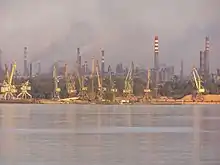
Zaporizhzhia is an important industrial centre of Ukraine, the country's main car manufacturing company, the Motor-Sich world-famous aircraft engine manufacturer. Well supplied with electricity, Zaporizhzhia forms, together with the adjoining Donets Basin (Donbas) and the Nikopol manganese and Kryvyi Rih iron mines, one of Ukraine's leading industrial complexes.
The city is a home of Ukraine's main automobile production centre, which is based at the Zaporizhzhia Automobile Factory (ZAZ), producing Ukrainian car brands such as Zaporozhets and Tavria.
After the end of the Russian Revolution, the city became an important industrial centre. The presence of cheap labor and the proximity of deposits of coal, iron ore, and manganese created favorable conditions for large-scale enterprises of the iron and mechanical engineering industries. Today Zaporizhzhia is an important industrial centre of the region with heavy industry (particularly metallurgy), aluminium, and chemical industry. Cars, avia motors and radioelectronics are manufactured in the city. The port of Zaporizhzhia is important for transshipment for goods from the Donbas.
Zaporizhstal, Ukraine's fourth largest steel maker, and ranking 54th in the world, is based in the city.
Electricity generation
Zaporizhzhia is a large electricity generating hub. There are hydroelectric power plant known as "DniproHES" Dnieper Hydroelectric Station and the largest nuclear power plant in Europe. Zaporizhzhia plants generate about 25% of the whole Ukrainian electricity consumption. The Zaporizhzhia Nuclear Power Plant is located near the Enerhodar (meaning energy gifter), around 60 km (37 miles) from Zaporizhzhia, which is the largest nuclear power plant in Europe. Also in Enerhodar, is the Zaporizhzhia Thermal Power Station.
Culture
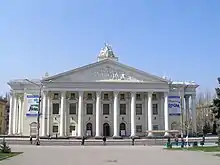
Zaporizhzhia has a philharmonic, few museums, theaters, libraries. Among them are:
- Magara Academic Drama Theatre
- Municipal Theatre Lab «VIE»
- Theatre for Young-Age spectators
- Theatre of Horse Riding «Zaporizhzhian Cossacks»
- Zaporizhzhia Regional Museum
- National Museum of Zaporizhzhian Cossacks History
- Zaporizhzhia Regional Art Museum
- Motor Sich Aviation Museum
- Zaporizhzhia Region Universal Scientific Library
There are a number of small amateur groups of folk music bands, art galleries in Zaporizhzhia. The city regularly holds festivals and feasts, competitions of the Cossack martial arts and art exhibitions.
Zaporizhzhia has an open-air exhibition-and-sale of Zaporizhzhia city association of artists «Kolorit» near the 'Fountain of Life' at the Mayakovskoho square. A daily exhibition of artists' organizations of the city is a unique place in Zaporizhzhia, where people can communicate with craftsmen and artists, watch classes of carving, embroidery, beading and other creative works, receive lessons from professional artists, designers, and cartoonists.
Main sights


The 12 km (7.5 mi) x 2 km (1.2 mi) island Khortytsia is located in the geographical centre of the city. The city embraces the island by banks of the New and Old Dnieper streams. Two concrete bridges connect the Island to the city. They have been designed and constructed by the engineer Boris N. Preobrazhensky in 1952. Two level bridges have height about 54 meters. High level of the bridges is intended for rail and bottom – for cars and pedestrians.
The historical and cultural museum "Zaporizka Sich" is placed on the northern rocky part of the island Khotritsa. The museum is the reconstructed stronghold of the Zaporizhzhian Cossacks. All features of the military cossack's camp life and their lifestyle are presented in the museum.
The smaller islands are located between the dam and the island Khortytsia. Each of these islands has its own legend. On one of them named Durnya Scala ("Rock of the Fool") Tzar Peter the Great punished the Cossacks by flogging for their betrayal on the side of Charles XII of Sweden during the Great Northern War between Russia and Sweden.
Another small island, named Stolb ("Pillar"), has a geological feature, which looks like a large bowl in granite slabs, its diameter equals 1.4 m (4.6 ft), the depth 1 m (3.3 ft). This bowl is named Cossack's bowl. People say that in summer days under the hot sun, it is easy to boil water in this "bowl" and the Cossacks used it for cooking galushki (boiled dough in a spicy broth).[94]
The panoramic view of the DnieproHES from Khortytsia island is very impressive. The straight and long Sobornyi avenue (10 km or 6.2 miles) ends in the SotsGorod near the Dam, which built up of the constructivist architecture of the 20th century.
Infrastructure
The city of Zaporizhzhia is an important transportation hub in Ukraine and has deeply developed transportation system that includes roadway, rail, river and air options for passenger, freight as well as public utilities transit. Public city transport includes buses, minivans, trams, trolleybuses and railways.
Roads
On the eastern outskirts Zaporizhzhia is passed by a major national highway M18 which connects Kharkiv with Simferopol. The H08 which starts just outside Kyiv and travels southeast along the Dnieper through Kremenchuk, Kamianske, Dnipro and passes through Zaporizhzhia on to Mariupol. Two other highways terminate in the city, the H15 which arrives from Donetsk and the H23 which starts in Kropyvnytskyi and through Kryvyi Rih ends in Zaporizhzhia.
There are four road bridges over Dnieper and two rail bridges. All bridges but one connect the city with Khortytsia island. The other bridge goes over the river dam of DniproHES. Early in 2022, President Volodymyr Zelenskyy opened the first stage of the new New Zaporizhzhia Dniper Bridge.
Railways
Zaporizhzhia city has two railway stations, Zaporizhzhia-the-First and Zaporizhzhia-the-Second. The First is the central station. It is located in the southern part of the city and is a part of the "north-south" transit route Simferopol-Kharkiv. The line of the Zaporizhzhia-the-Second station connects the Donbas coalfield with Kryvyi Rih iron ore site.
Water transportation
The city's two river ports are part of the national water transportation infrastructure that connects Kyiv to Kherson along Dnieper river and utilizes some freight ships as well as cutter boats to travel between Zaporizhzhia and nearby villages. The large island of Khortytsia splits the Dnieper into two branches (channels) the main branch that passes the island on its eastern side and the alternative branch also known as Staryi Dnipro (Old Dnieper) that flows past the island on its western side.
Airport
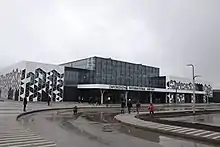
The city's sole airport located to the east of the city on the left-bank of the Dnieper serves both domestic and international flights. To the west of the city on the right-bank of the Dnieper there is a smaller airfield called Shyroke.
Notable people
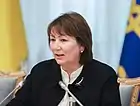
.jpg.webp)
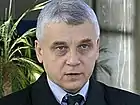

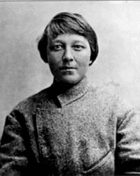
- Alyosha (born 1986), Ukrainian singer, stage name of Olena Oleksandrivna Kucher
- Vasiliy Bebko, (1932-2022), Russian diplomat
- Tamara Bulat (1933-2004), Ukrainian-American musicologist
- Victoria Bulitko (born 1983), a Ukrainian film, TV and theatre actress.
- Evgeniy Chernyak (born 1969), Ukrainian businessman
- Evgeniy Chuikov (1924-2000) Ukrainian landscape painter working in the Russian realist and French Impressionist traditions.
- Volodymyr Dakhno (1932-2006) Ukrainian animator and animation film director.
- Valentyna Danishevska (born 1957), Ukrainian lawyer and judge
- Gerhard Ens (1863–1952), farmer, immigration agent and politician in Saskatchewan
- Igor Fesunenko (1933-2016), Russian journalist and foreign affairs writer
- Sergey Glazyev (born 1961), Russian politician and economist
- Alina Gorlova (born 1992), a Ukrainian filmmaker, director, and screenwriter
- Konstantin Grigorishin (born 1965), a Russian-Ukrainian businessman and billionaire.
- Volodymyr Horbulin (born 1939), Ukrainian politician
- Valeriy Ivaschenko (born 1956), Ukrainian former Deputy Minister of Defence
- Boris Ivchenko, (1941-1990) Ukrainian actor and film director
- Igor P. Kaidashev (born 1969), Ukrainian immunologist and allergist
- Valeriy Kostyuk (born 1940), Russian scientist
- Maxim Ksenzov (born 1973), Russian statesman
- Valery Kulikov (born 1956), Ukrainian-born Russian politician
- Gosha Kutsenko (born 1967), Russian actor, producer, singer, poet and screenwriter
- Valentyn Nalyvaichenko (born 1966), Ukrainian diplomat and politician.
- Eva Neymann (born 1974), Ukrainian film director
- Maria Nikiforova (1885–1919), revolutionary insurgent and Anarchist partisan leader.
- Anna October (born 1991), Ukrainian fashion designer
- Aleksandr Panayotov (born 1984), Russian-Ukrainian singer and songwriter
- Mykhailo Papiyev (born 1960), Ukrainian engineer and politician
- Oleksandr Peklushenko, (1954-2015) Ukrainian politician
- Max Polyakov (born 1977), an international technology entrepreneur, economist and philanthropist
- Georgy Shchokin (born 1954), businessman, sociologist, psychologist and politician
- Boris Shtein, (1892–1961) Soviet diplomat
- Oleksandr Sin (born 1961), Ukrainian politician former mayor of Zaporizhzhia
- Serhiy Sobolyev (born 1961), Ukrainian politician
- Yanina Sokolova (born 1984) a journalist, TV presenter and actress.
- Naum Sorkin, (1899–1980) a Soviet military officer and diplomat.
- Oleksandr Starukh (born 1973), Ukrainian historian and politician
- Liudmyla Suprun (born 1965), a Ukrainian politician
- Yevhen Synelnykov (born 1981), a Ukrainian TV presenter, director and actor
- Estas Tonne (born 1975), a musician, plays guitar and flute
- Vladyslav Yama (born 1982), a Ukrainian dancer and educator
Sport
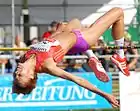

- Polina Astakhova (1936–2005) an artistic gymnast; won ten medals at the 1956, 1960 and 1964 Summer Olympics.
- Anastasia Bliznyuk (born 1994), a Russian group rhythmic gymnast.
- Maksym Dolhov (born 1996), Ukrainian diver
- Tanja Logwin (born 1974), Ukrainian-born Austrian handball player
- Alina Maksymenko (born 1991), Ukrainian rhythmic gymnast
- Oleksii Pashkov (born 1981), silver medallist in the discus at the 2012 Summer Paralympics
- Volodymyr Polikarpenko (born 1972), Ukrainian former trialthon athlete
- Yakiv Punkin (1921–1994) wrestler, gold medallist at the 1952 Summer Olympics.
- Oksana Skaldina (born 1972) gymnast; bronze medallist at the 1992 Summer Olympics
- Ganna Sorokina (born 1976) diver; team bronze medallist at the 2000 Summer Olympics
- Olga Strazheva (born 1972) gymnast; team gold medallist at the 1988 Summer Olympics
- Vita Styopina (born 1976) high jumper; bronze medallist at the 2004 Summer Olympics
- Denys Sylantyev (born 1976) politician and swimmer; four time Olympian, silver medallist at the 2000 Summer Olympics and national flag bearer at the 2004 Summer Olympics.
- Razmik Tonoyan (born 1988), Ukrainian sambist, (a Soviet-origin Russian martial art)
- Roman Volod'kov (born 1973), Ukrainian former diver
- Sergiusz Wołczaniecki (born 1964) a Polish weightlifter; bronze medallist at the 1992 Summer Olympics
- Olena Zhupina (born 1973), Ukrainian diver
In popular culture
Zaporizhzhia is an important setting in two Axis victory in World War II short fictions by the American author Harry Turtledove: Ready for the Fatherland (1991) and The Phantom Tolbukhin (1998). Turtledove always uses the Zaporozhye spelling.
Twin towns and sister cities
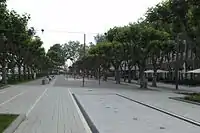
Zaporizhzhia has an agreement about sister city relations with:[95][96]
 Lahti, Finland, since 1953[95]
Lahti, Finland, since 1953[95] Belfort, France, since 1967[95][97]
Belfort, France, since 1967[95][97] Birmingham, United Kingdom, since 1973[95][98]
Birmingham, United Kingdom, since 1973[95][98] Linz, Austria, since 1983[95]
Linz, Austria, since 1983[95] Oberhausen, Germany, since 1986[95]
Oberhausen, Germany, since 1986[95] Yichang, China, since 1993[95]
Yichang, China, since 1993[95] Magdeburg, Germany, since 2008[95][99]
Magdeburg, Germany, since 2008[95][99] Chongqing, China
Chongqing, China Zestaponi, Georgia
Zestaponi, Georgia.svg.png.webp) Steinbach, Canada, since 2018
Steinbach, Canada, since 2018
In addition, in 1969 the city renamed one of its streets "Wrocław", the Wrocław communist government acknowledging that they should honour the Ukrainian city in a similar way and a part of the Sudecka – Grabiszyńska street towards the square of the Silesian Insurgents – was renamed to Zaporoska street. It is about 1.3 km (0.81 miles) long.[100]
See also
- Zaporizhzhia Ferroalloy Plant
- Zaporizhzhia Foundry and Mechanical Plant
Notes
- This image of a kurgan stele has been taken in Kharkiv, but one may find similar statues at Khortytsia Island.
- Lost Victories, by Field Marshal Eric von Manstein, says that the Germans finished repairing the railway bridge only a few months before they lost the city in October 1943. "As a result all goods had to be reloaded and tank-wagons carrying petrol could not go through to the front."
- Lieutenant Mykola Yatsenko (1923–1943) was a platoon commander in 39 Tank Brigade (23rd Tank Corps, South-Western Front); early on 14 October 1943 his tank entered the city and destroyed three enemy tanks in street fighting; Yatsenko was killed. He was posthumously made a Hero of the Soviet Union in 1944. His crew members were: Sergeant Varecun (driver), Lebedev (gunner), and Shepelev (radio-operator).[34]
- Since modern Zaporizhiazhia was greatly enlarged in the Soviet Union, many typography in the city had to be renamed. In the year of the fall of the Russian Empire (1917), the population of Alexandrovsk was about 60,000 people. In the year of Ukraine's declaration of independence (1991), the city's population reached almost 1 million people.
References
- (in Ukrainian) The mayor of Zaporozhye was fired, Ukrayinska Pravda (30 September 2021)
- The size and composition of the population of Zaporizhzhia region up to the Ukrainian population census 2001 (Численность и состав населения Запорожской области по итогам Всеукраинской переписи населения 2001 года). (in Russian)
- (in Ukrainian)
- "Про затвердження транслітерації написання географічної назви міста Запоріжжя латиницею. Рішення виконавчого комітету №476". Zaporizhzhia city council. Executive committee. 28 August 2017.
- Pospelov, pp. 25–26
- Я. П. Новицкий. История города Александровска, (Екатеринославской губ.) в связи с историей возникновения крепостей Днепровской линии 1770–1806 г. – Екатеринослав: Типография Губернского Земства, 1905. – 176 с. (in Russian)
- Віталій Бондар, Ірина Козлова. (25 September 2010). Таємниці унікальних документів (in Ukrainian). Запорізька правда.
- З історії Олександрівська (in Ukrainian)
- Natalia Ostasheva Venger (2003). "The Mennonite Industrial Dynasties in Alexandrovsk". Journal of Mennonite Studies. Vol. V21. Dnepropetrovsk National University. pp. 89–110.
- Friesen, R. Building on the Past: Mennonite Architecture, Landscape and Settlements in Russia/Ukraine. Raduga Publications, 2004.
- The bridges of Zaporizhzhia (Мосты Запорожья), by L. Adelberg (Адельберг Л), pub RA Tandem st, Zaporizhzhia, 2005. (in Russian)
- Official Portal Zaporizhzhia city authorities, History (Офіційний портал, Запорізької міської влади, Історія міста) Archived 21 January 2012 at the Wayback Machine, accessed 11 April 2011. (in Ukrainian)
- "Sovetskai︠a︡ arkhitektura". Искусство. 27 October 1969 – via Google Books.
- New world review, p40
- Меерович М. Г. Соцгород – базовое понятие советской градостроительной теории первых пятилеток Archived 28 September 2011 at the Wayback Machine
- "История Запорожья". photoalbum.zp.ua.
- The Soviet economy and the Red Army, 1930–1945, by Walter Scott Dunn, Greenwood Publishing Group, 1995 ISBN 0-275-94893-5, page 13.
- "Колли Николай Джемсович". bse.sci-lib.com.
- V.E. Alyeshin, Dissertation, (Алёшин В. Э., Глава III. Практическое воплощение теоретический идеи в градостроительстве Украины в период индустриализации и первой пятилетки. Развитие представления о социалистическом поселении в градостроительстве Украины в 1920–х – начале 1930–х годов (Диссертация на соискание ученой степени кандидата архитектуры)) (in Russian).
- The Great Patriotic War on the territory of Zaporizhzhia (Великая Отечественная война на территории Запорожья) (in Russian)
- Germany and the Second World War, Volume IV The Attack on the Soviet Union, by Horst Boog, Jürgen Förster, Joachim Hoffmann, Ernst Klink, Rolf-Dieter Müller, Gerd R. Ueberschär, pub Clarendon Press, 1998, ISBN 0-19-822886-4, p 909.
- "The Eastern Front, Timeline 1941". Archived from the original on 19 July 2011. Retrieved 18 April 2011.
- Radio Free Europe Radio Liberty, Ukrainian Activists Draw Attention To Little-Known WWII Tragedy , by Dmytro Moroz and Claire Bigg, 23 August 2013.
- Germany and the Second World War, Volume IV The Attack on the Soviet Union, p 607 says that Zaporizhzhia was captured on 1 October 1941.
- Lost Victories, by Field Marshal Eric von Manstein, pdf version p263.
- Germany and the Second World War, Volume VI The Global War, by Horst Boog, Werner Rahn, Reinhard Stumpf, and Bernd Wegner, pub Clarendon Press, 2001, ISBN 0-19-822888-0, p 1184–1193.
- Lost Victories, by Field Marshal Eric von Manstein, translated by Anthony G Powell, pdf version p267-270.
- Lost Victories, by Field Marshal Eric von Manstein, pdf version p 274.
- There are photographs of Hitler's meeting at HQ Army Group South taken by Heinrich Hoffmann in the Bavarian State Library Archived 16 May 2011 at the Wayback Machine; the library records show them as taken on 10 March 1943. The following instructions will find the photos on the site:
- Special collections->Image archive->Start search->Freie suche-> type Manstein ->click "Suchen" -get results-> Look at photos 28–43.
- Lost Victories, by Field Marshal Eric von Manstein, pdf version p290-2.
- Lost Victories, by Field Marshal Eric von Manstein, says that the Germans finished repairing the railway bridge only a few months before they lost the city in October 1943.
- "The Eastern Front, Timeline 1943". Archived from the original on 19 July 2011. Retrieved 18 April 2011.
- Moscow-Stalingrad-Berlin-Prague, Memories of Army Commander ("Москва-Сталінград-Берлін-Прага". Записки командарма), by Dmitri Danilovich Lelyushenko (Лелюшенко Дмитро Данилович), pub Nauka, Moscow, 1987, chapter 4.
- Zaporizhzhia Streets – The Mirror of History: brief biographical directory and lists of streets, alleys, boulevards, avenues and streets of the town (Вулиці Запоріжжя – дзеркало історії: довідник і короткі бібліографічні списки про вулиці, провулки, проспекти, бульвари та майдани міста), by Uklad O Dutova (Уклад О Дутова), pub Дике Поле, 2008. (in Ukrainian)
- Почему мосты строят по 14 лет – и что говорит Укравтодор
- Lychovchuk, Valeria (13 November 2020). "ДОЛГАЯ ДОРОГА ЧЕРЕЗ ДНЕПР. ТАК БУДУТ ЛИ У ЗАПОРОЖЬЯ НОВЫЕ МОСТЫ?" [Long road through the Dnieper: Will there be new bridges in Zaporizhzhia?]. Zaporizhzhia Future (in Russian).
- Buckley, Neil (26 January 2014). "Ukraine protests spread to Yanukovich heartland". Financial Times.
- "В Запорожье участники Майдана опечатали кабинеты руководства Запорожской ОГА : Новости УНИАН". Ukrainian Independent Information Agency. Retrieved 24 February 2014.
- Ukraine Tensions Escalate as Russia, U.S. Exchange Barbs Archived 15 September 2014 at the Wayback Machine
- Ukraine crisis: What is happening where?, BBC News (15 April 2014)
- "Armed, pro-Russian separatists lay siege to Donetsk Oblast; at least three dead (VIDEOS, UPDATES) – Apr. 14, 2014". 14 April 2014.
- Poroshenko signed the laws about decomunization. Ukrayinska Pravda. 15 May 2015
Poroshenko signs laws on denouncing Communist, Nazi regimes, Interfax-Ukraine. 15 May 20
Goodbye, Lenin: Ukraine moves to ban communist symbols, BBC News (14 April 2015) - Vitaly Shevchenko (1 June 2016), In pictures: Ukraine removes communist-era symbols, BBC News
- Полный перечень переименованных в Запорожье улиц
- (in Ukrainian) In Zaporizhzhia began to "dekomunize" DniproGES, Radio Free Europe (4 April 2016)
- "Техніка росіян зайшла до Бердянська, в Запоріжжі зброю дають усім готовим захищати обласний центр". Радіо Свобода (in Ukrainian). Archived from the original on 27 February 2022. Retrieved 28 February 2022.
- "Жителів Запоріжжя просять не покидати укриття: Обстрілюють аеродром – новини Запоріжжя". www.depo.ua (in Ukrainian). Archived from the original on 27 February 2022. Retrieved 28 February 2022.
- "Video analysis reveals Russian attack on Ukrainian nuclear plant veered near disaster". NPR. 11 March 2022. Retrieved 1 April 2022.
- "Update 1-Ukraine nuclear power plant Zaporizhzhia on fire, town mayor says". Reuters. 4 March 2022. Retrieved 7 March 2022.
- "Invaders fire missiles on Zaporizhzhia, Sumy region at night".
- "Ukraine war: Survivors speak of horror as Zaporizhzhia convoy hit". BBC News. 30 September 2022. Retrieved 30 September 2022.
- Malsin, Jared (30 September 2022). "Ukrainian Forces Move to Surround Russian Troops in Key City as Putin Lays Claim to Regions". Wall Street Journal. ISSN 0099-9660. Retrieved 30 September 2022.
- Landay, Jonathan (30 September 2022). "At least 30 civilians killed in Russian strike on convoy, Ukraine says". Reuters. Retrieved 30 September 2022.
- "Ukrainian national police say the toll in Russia's shelling Friday of Zaporizhzhia has risen to 30 dead, 88 wounded". Retrieved 1 October 2022.
- Ivanova, Polina; Miller, Christopher; Seddon, Max; Olearchyk, Roman (9 October 2022). "Vladimir Putin blames Ukrainian 'terrorism' for Crimea bridge explosion". Financial Times. Archived from the original on 9 October 2022. Retrieved 9 October 2022.
- "At least 17 are killed in Zaporizhzhia". The New York Times. 9 October 2022. Archived from the original on 9 October 2022. Retrieved 9 October 2022.
- Spike, Justin; Schreck, Adam (9 October 2022). "Ukraine: Russian strikes kill 17 following bridge attack". Associated Press. Archived from the original on 9 October 2022. Retrieved 9 October 2022.
- "Паспорт города Запорожье". photoalbum.zp.ua.
- "The interactive map of island of Khortitsa (Russian)". Archived from the original on 2 July 2011. Retrieved 2 July 2011.
- ПОГОДА в Запорожье (in Russian). Погода и климат. Archived from the original on 13 December 2019. Retrieved 8 November 2021.. Snow days have been taken to mean days on which it snowed, not days with snow cover on the ground.
- "World Meteorological Organization Climate Normals for 1981–2010". World Meteorological Organization. Archived from the original on 17 July 2021. Retrieved 18 July 2021.
- Головне управління статистики в Запорізькій області — Чисельність населення м. Запоріжжя Archived 13 February 2019 at the Wayback Machine на 1 листопада 2015 року]
- "Zaporizhzhia · Population". population.city.
- "Держстат України" (PDF). Archived from the original (PDF) on 25 February 2022. Retrieved 4 July 2018.
- Collection of scientific works of graduate students (Збiрник наукових праць аспірантів), by T H Shevchenka, pub Vyd-vo Kyïvsʹkoho University, 1963, p87 gives the 1861 population as 3,729. (in Ukrainian)
- Ripley, George; Dana, Charles A. (Charles Anderson) (27 October 1879). "The American cyclopaedia: a popular dictionary of general knowledge. Edited by George Ripley and Charles A. Dana". New York D. Appleton – via Internet Archive.
- Brockhaus and Efron's Encyclopedia (Энциклопедический Словарь Ф.А.Брокгауза и И.А.Ефрона), edited by Professor IE Andreevskago, and K. Arseniev, pub FA Brockhaus (Leipzig) and IA Efron (St Petersburg), 1890–1907, entry for Aleksandrovsk in Yekaterinoslavskaya province (Александровск, уездный город Екатеринославской губернии). (in Russian)
- Universal Calendar for 1898 (Всеобщий календарь на 1898 год), pub Hermann Hoppe (St Petersburg), 1898, p217 List of the populated areas of the Russian Empire, Abakan – Alekseevskoe (Роспись населённых местностей Российской империи, Абаканское – Алексеевское). (in Russian)
- Large Encyclopedia (Большая Знциклопедія) Volume I, pub Prosveshechenie (St Petersburg), 1903, p323. pdf version (in Russian)
- Russian Calendar for 1906 (Русский календарь на 1906 г.), pub A. Suvorina (St Petersburg), 1906, p108 List of the populated areas of the Russian Empire, Abbas-Tuman – Belev (Список городов и других населённых пунктов Российской империи, Аббас-Туман – Белев). (in Russian)
- Ukrainian SSR (Украинская ССР), pub Economic Institute of the Ukrainian Academy of Sciences, 1958, p87.
- Sergina V. "City Z:1921-199", film "Year 1926" Сергина В. Город Z: 1921–1991 (Невыдуманные истории): Исторически–познавательный ТВ проект для любой зрительской аудитории. – К., 2005. – 1 компакт – диск. Фильм "Год 1926"
- Economic geography of the USSR by S S Balźak, V F Vasyutin, Ya G Feigin, pub Macmillan, 1956.
- Half a century classified as 'Secret': All-Union census in 1937 (Полвека под грифом 'секретно': Всесоюзная перепись населения 1937 года) Archived 25 May 2013 at the Wayback Machine, by Valentina B Zhiromskaya, I Kiselev, Yu A Polyakov, pub Nauka, 1996. This gives the 1926 population as 55,295.(DJV-ZIP – requires DjVu viewer software) (in Russian)
- The emergency evacuation of cities: a cross-national historical and geographical study, by Wilbur Zelinsky, Leszek A. Kosiński, pub Rowman & Littlefield, 1991, ISBN 0-8476-7673-0.
- The Great Soviet Encyclopedia (Большая Советская Энциклопедия), entry for Zaporizhzhia – Zaporizhzhia oblast centre (Запорожье – центр Запорізької обл.), 3rd edition, pub 1969 to 1978. (in Russian)
- Sergina V. "City Z:1921-199", film "Year 1942" (Сергина В. Город Z: 1921–1991 (Невыдуманные истории): Исторически–познавательный ТВ проект для любой зрительской аудитории. – К., 2005.- 1 компакт – диск. Фильм "Год 1942") said the population for 1942 was 103,400.
- The Ukrainian quarterly, Volumes 26–27, pub Ukrainian Congress Committee of America, 1970, p223.
- The population of the USSR: According to the Proc. Census 1979 (Население СССР: По данным Всесоюзной переписи населения 1979 г.), pub Politizdat (Moscow), 1980 – table: USSR, the Soviet population in 1979, cities with a population of 100 thousand and more people (СССР, население СССР на 1979 год, Население союзных и автономных республик). (in Russian)
- www.larousse.fr/encyclopedie L’Encyclopédie en ligne entry for Zaporojie. (in French)
- Rand McNally atlas of world geography, pub Rand McNally Company, 1996, p38.
- Population on 1 August 2010 (Чисельність населення на 1 серпня 2010 року), press release No 1377 issued by the State Department of Statistics in the Zaporizhzhia oblast (Держкомстат. Головне управління статистики у Запорізькій області), 16 September 2010. (in Ukrainian)
- Population on 1 March 2011 (Чисельність населення на 1 березня 2011 року), press release No 1163 issued by the State Department of Statistics in the Zaporizhzhia oblast (Держкомстат. Головне управління статистики у Запорізькій області), 18 April 2011. (in Ukrainian)
- "ЧИСЕЛЬНІСТЬ НАЯВНОГО НАСЕЛЕННЯ УКРАЇНИ" (PDF) (in Ukrainian). 1 January 2017. Archived from the original (PDF) on 25 February 2022. Retrieved 4 July 2018.
- Лозовой Н. (17 January 2011). "Этнические войны: украинская версия". Истеблишмент. Archived from the original on 15 August 2011.
- Helena Krasowska,The Polish Minority in South-Eastern Ukraine, pub Institute of Slavic Studies, Polish Academy of Sciences, 2017, ISBN 978-83-64031-65-6, p. 49.
- "Demoskop Weekly: Prilozhenie. Spravochnik statisticheskikh pokazateleĭ" Демоскоп Weekly - Приложение. Справочник статистических показателей. [Demoscope Weekly: appendix. Digest of statistical indicators.]. www.demoscope.ru. Retrieved 15 January 2021.
- Vsesoi͡uznai͡a perepisʹ naselenii͡a 1926 goda Всесоюзная перепись населения 1926 года [All-union census of population 1926]. Moscow: Издание ЦСУ Союза ССР. 1928–29.
- Romant͡sov, V. O. "Населення України і його рідна мова за часів радянської влади та незалежності" Naselenni͡a Ukraïny i ĭoho ridna mova za chasiv radi͡ansʹkoï vlady ta nezalez͡hnosti [The population of Ukraine and its native language in the periods of the Soviet régime and independence]. Archived from the original on 6 March 2016. Retrieved 15 January 2021.
- "Vseukraïnsʹkyĭ perepys naselenni͡a 2001 roku: Rozpodil naselenni͡a za ridnoi͡u movoi͡u, Zaporizʹka oblastʹ" Всеукраїнський перепис населення 2001 року. Розподіл населення за рідною мовою, Запорізька область [All-Ukrainian census of population 2001: Distribution of population by native language, Zaporizka oblast.]. Archived from the original on 6 March 2016. Retrieved 1 June 2021.
- "Религиозная карта области". Остров Свободы (in Russian). Archived from the original on 17 June 2008. Retrieved 17 April 2011.
- Helena Krasowska,The Polish Minority in South-Eastern Ukraine, pub Institute of Slavic Studies, Polish Academy of Sciences, 2017, ISBN 978-83-64031-65-6, p. 50-52.
- Galina and Maxim Ostapenko, History of our Khortytsia (Галина и Максим Остапенко История нашей Хортицы) Archived 31 August 2011 at the Wayback Machine
- Міста-побратими м. Запоріжжя [Twin Cities Zaporizhzhia]. City of Zaporizhzhia (in Ukrainian). Шановні відвідувачі і користувачі сайту. Archived from the original on 3 August 2012. Retrieved 7 August 2013.
- Беляева Л. Города-побратимы Запорожья // Правда. – 2011. – № 16. – С. 9.
- "Belfort – Les Relations Internationales" [Belfort – International Relations]. Belfort Mairie (in French). Archived from the original on 20 July 2011. Retrieved 21 December 2013.
- ‘Zaporozhe : Birmingham’s twin city in the USSR’. Typescript (photocopy), [1980]Birmingham and Zaporizhia, Ukraine. Twin cities, back in the USSR?
- Zachert, Uwe; Annica Kunz. "Twin cities". Landeshauptstadt Magdeburg [City of Magdeburg]. Archived from the original on 1 September 2012. Retrieved 7 August 2013.
- "Wrocław, ul. Zaporoska – Dolny.Slask.org.pl". Archived from the original on 29 September 2011. Retrieved 29 July 2011.
Sources
- Е. М. Поспелов (Ye. M. Pospelov). "Имена городов: вчера и сегодня (1917–1992). Топонимический словарь." (City Names: Yesterday and Today (1917–1992). Toponymic Dictionary." Москва, "Русские словари", 1993.
External links
- Official portal of Zaporizhzhia City (in Ukrainian)
- One of the portals of Zaporizhzhia City (in Russian)
- Another one of the portals of Zaporizhzhia City (in Russian)
- Zaporizhzhia seven ways to adventure
- One of the few external reports on the city in English is the BBC report "Ukraine: Why the Orange Revolution ran out of steam", Daniel Sandford, Moscow correspondent, BBC News 10 March 2011.